
UX Design: The Ultimate Guide 2024
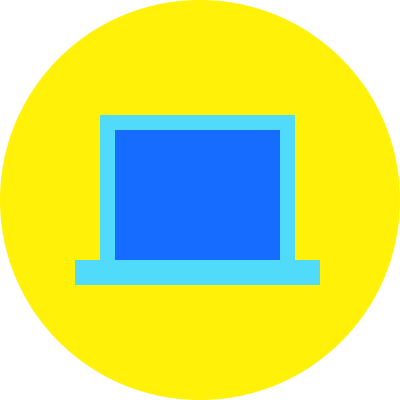
Contents

What is your digital IQ?
Unlock your full potential with our Digital IQ test. Discover your strengths and weaknesses.
UX Design Introduction

UX Design Introduction
What is UX Design
UX Definition
UI vs UX Design
UX Designer Salary
UX Design Process
UX and Usability Testing
UX Design Examples
UX Design Tools
How to become a UX Designer
UX Designer Portfolio
Final Thoughts
UX Design Introduction
UX design has steadily become one of the most in-demand and sought after professions in the creative world.
In 2020, LinkedIn reported UX design as one of the top 5 most in-demand professions.
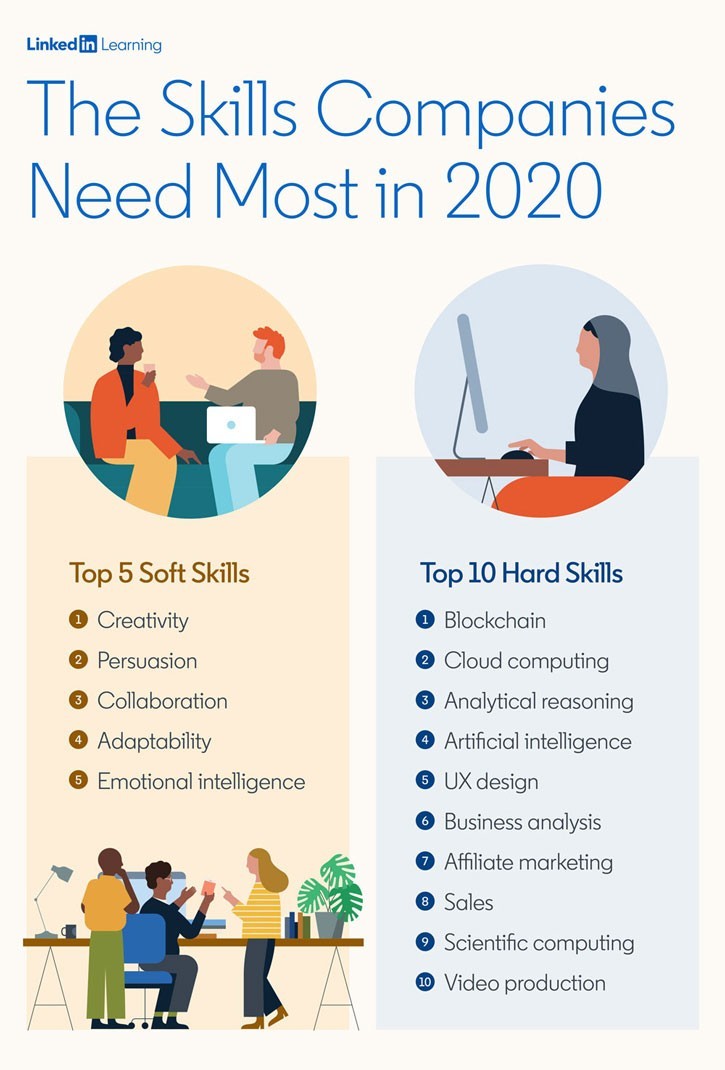
Also, take note of the “soft skills” that companies are looking for too. These soft skills are synonymous with great designers and the good news is you may already have them.
Excellent UX design is about creating a user experience that is a joy to behold and one that offers users a solution to their problems.
In this guide, we’ll address everything you need to know about UX design, its various design processes and how to go about becoming one yourself.
What is UX Design?

UX Design Introduction
What is UX Design
UX Definition
UI vs UX Design
UX Designer Salary
UX Design Process
UX and Usability Testing
UX Design Examples
UX Design Tools
How to become a UX Designer
UX Designer Portfolio
Final Thoughts
What is UX Design?
UX design encompasses every aspect of the design process that takes a product from conception, all the way through to its final form and into the hands of the end-user.
Here’s an example of the general design process broken down into 6 steps:
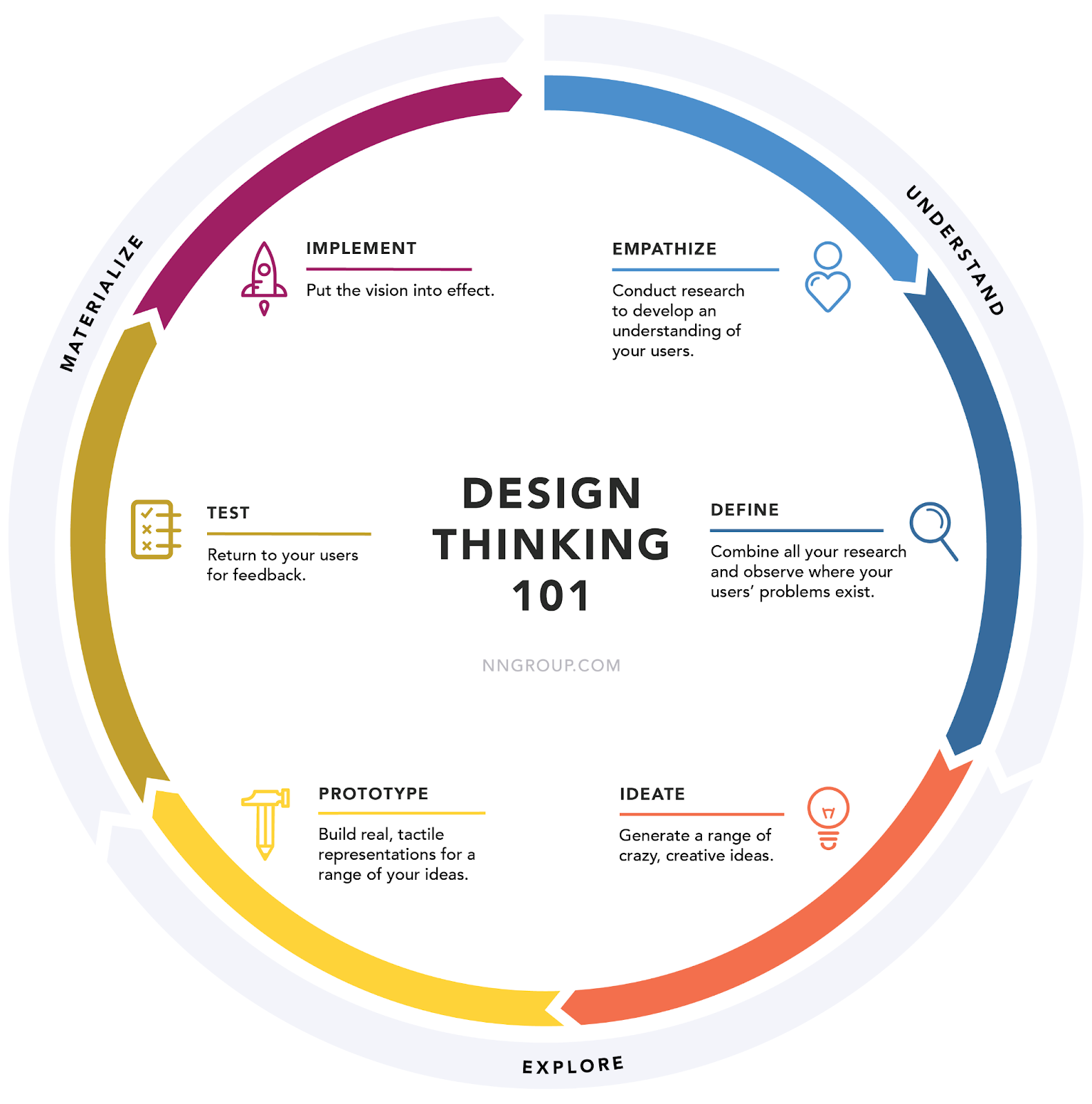
This could be how a physical product feels to hold and interact with, or a digital experience, like how straightforward it is to sign up for a mailing list or complete an online retailer’s checkout process.
Take this example of a user flow for the Apple Watch:
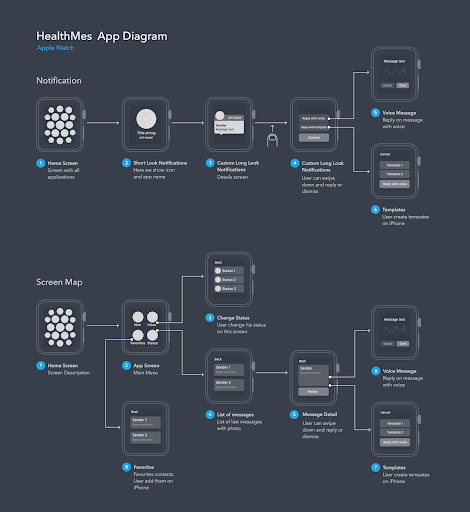
You’ll see here that Apple is trying to meet its user’s expectations every step of the way. Their focus is on making the user experience flexible, clear and usable.
These types of experiences are shaped by several things, all of which combined, play a part in the design process.
As a designer, you’ll spend time researching the market, compiling data analytics to better understand your target audience’s mindset, and collaborating on visual elements such as graphics and typography.
For a deeper insight read our blog on What Is User Experience Design.
UX Definition

UX Design Introduction
What is UX Design
UX Definition
UI vs UX Design
UX Designer Salary
UX Design Process
UX and Usability Testing
UX Design Examples
UX Design Tools
How to become a UX Designer
UX Designer Portfolio
Final Thoughts
UX Definition
In short, UX or User Experience refers to how we, the consumer, interact with a product or service.
The objective for an impeccable user experience is to meet the precise needs of the user without barriers, confusion or frustration.
These are the fundamentals that epitomise the user experience.
Don Norman, the co-founder of the User Experience and Usability consulting firm, Nielson Norman group, shares his ideology for what UX should be:
“It’s not enough that we build products that function, are understandable and usable, we also need to build products that bring joy and excitement, pleasure and fun, and yes, beauty to people’s lives.”
Norman’s take on user experience places a finer point on what it means to truly be a UX designer.
Yes, it’s about form and function but deeper than that, UX design should stir our emotions and facilitate the connection we have to a product.
UI vs UX Design

UX Design Introduction
What is UX Design
UX Definition
UI vs UX Design
UX Designer Salary
UX Design Process
UX and Usability Testing
UX Design Examples
UX Design Tools
How to become a UX Designer
UX Designer Portfolio
Final Thoughts
UI vs UX Design
Closely related, UI or ‘user interface’ and UX or ‘user experience’ - coexist in the design process.
UI refers to the visual elements that appear on the interface itself and how the user interacts with them.
Aesthetics such as graphics, colour palettes, branding, and typography like font and style are all components of UI.
The interactive elements would be things like navigation between menus and pages, landing pages, clickable buttons or CTA’s and responsiveness (how it appears on different size screens).
UX on the other hand focuses on the entire customer journey.
The objective for UX is to lead the user from the point of enquiry to the point of completion, intuitively and hassle-free.
Read our full breakdown for the differences between UI and UX design here. Also, take a look at this article explaining 47 key lessons on UI/UX designers and debunk some of those UX myths floating around.
And if you’re curious what a day in the life of a UX/UI designer looks like; check out this breakdown from one of Google’s very own.
UX Designer Salary

UX Design Introduction
What is UX Design
UX Definition
UI vs UX Design
UX Designer Salary
UX Design Process
UX and Usability Testing
UX Design Examples
UX Design Tools
How to become a UX Designer
UX Designer Portfolio
Final Thoughts
UX Designer Salary
Now we’re getting down to business.
If you’re wondering what a UX designer gets paid we’ll break down the average salary and the associated roles and responsibilities.
Like many creative professions, there are multiple levels of experience with each level bearing a higher salary.
Spoiler alert - UX design is highly in-demand, well-compensated and provides plenty of opportunities for career progression.
What a UX designer job description looks like
Taken from Indeed, here are some typical job descriptions for UX designers.
Junior UX Designer:
- Working with our UI/UX Designers, Writers, Creatives, Project Managers and Developers to deliver compelling digital user experiences
- Conducting user research and creating personas
- Analysing user data and user behaviour
- Helping to run workshops with clients
- Defining user journeys and the IA of websites
- Producing wireframes and interactive prototypes
- Usability testing with real users
- Presenting findings internally and to clients
Jumping up the ladder to a mid-senior level designer, the roles and responsibilities might look like this:
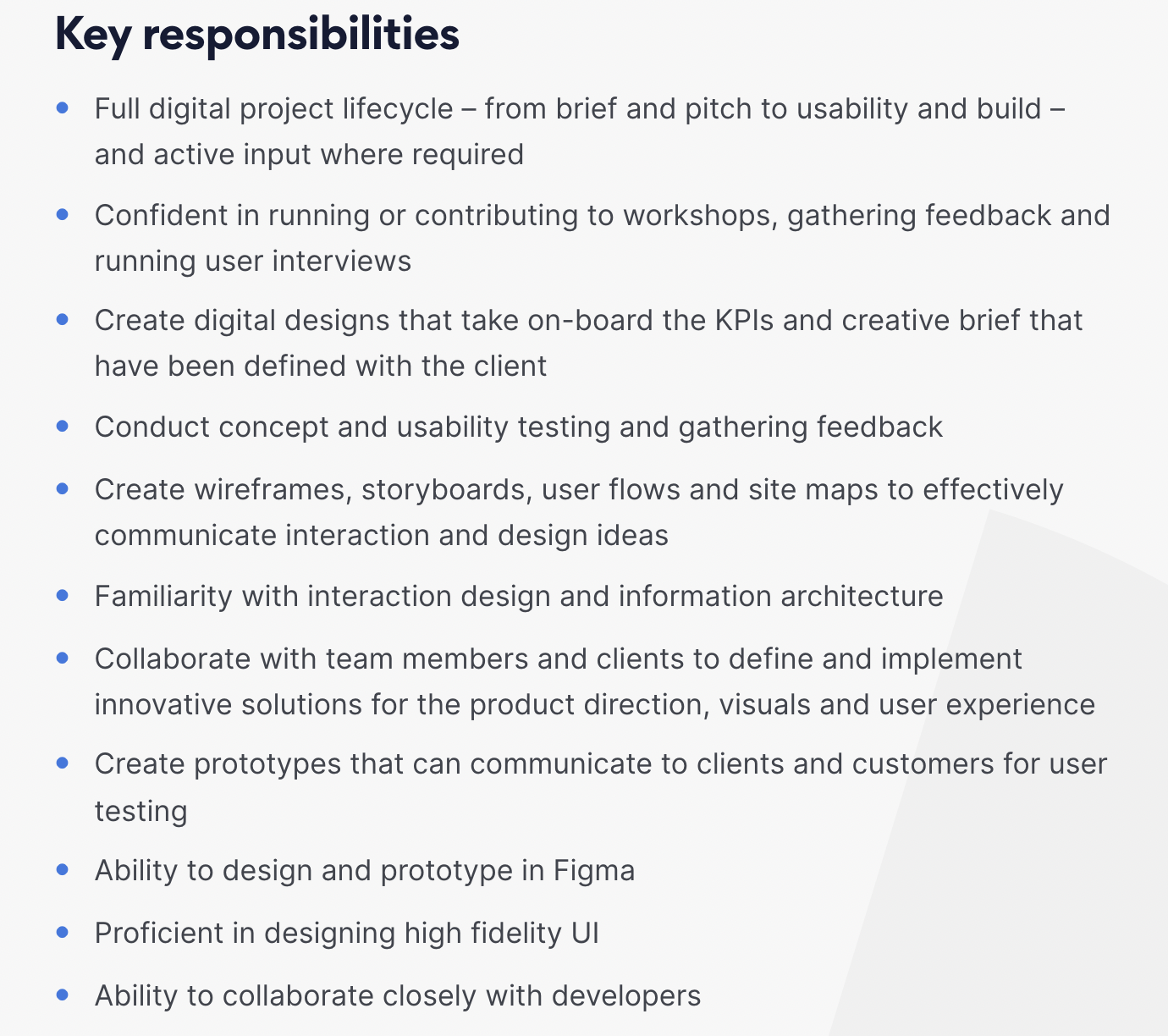
So what does this tell us?
As mentioned in the previous chapters, there’s an emphasis on these key skills:
UX designers at any level will develop and implement the same fundamental knowledge and skillsets for effective design.
UX design salaries by country
The graphic below gives an overview of what you can expect to earn as a UX designer dependent on location.
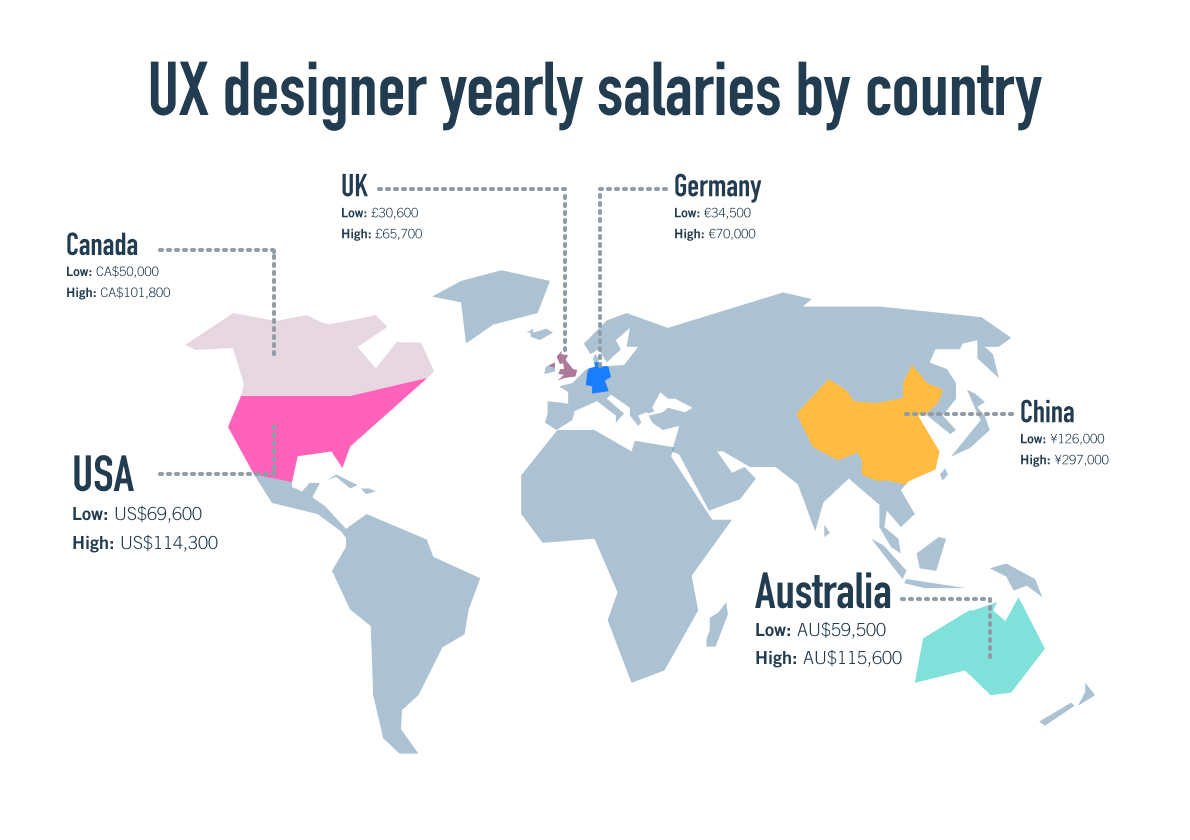
The countries shown here represent the largest demand for UX designers and we think you’ll agree, the pay is decidedly competitive across the board.
Countries like the USA have a naturally higher demand being home to technological hubs like Seattle, California and New York with companies such as Amazon, IBM and Google pioneering the way in which we interact with technology.
One of the many positive attributes of UX design is the ability to work from anywhere, remotely.
Since Covid-19 there’s a vast array of companies supporting remote work which means you can apply for UX positions regardless of where you’re based.
UX Design Process

UX Design Introduction
What is UX Design
UX Definition
UI vs UX Design
UX Designer Salary
UX Design Process
UX and Usability Testing
UX Design Examples
UX Design Tools
How to become a UX Designer
UX Designer Portfolio
Final Thoughts
UX Design Process
Depending on the type of product you’re tasked with building, the design process will vary slightly but as a general rule, there is a universal structure for how a design process looks.
The University of Illinois explains the general design process in this graphic:
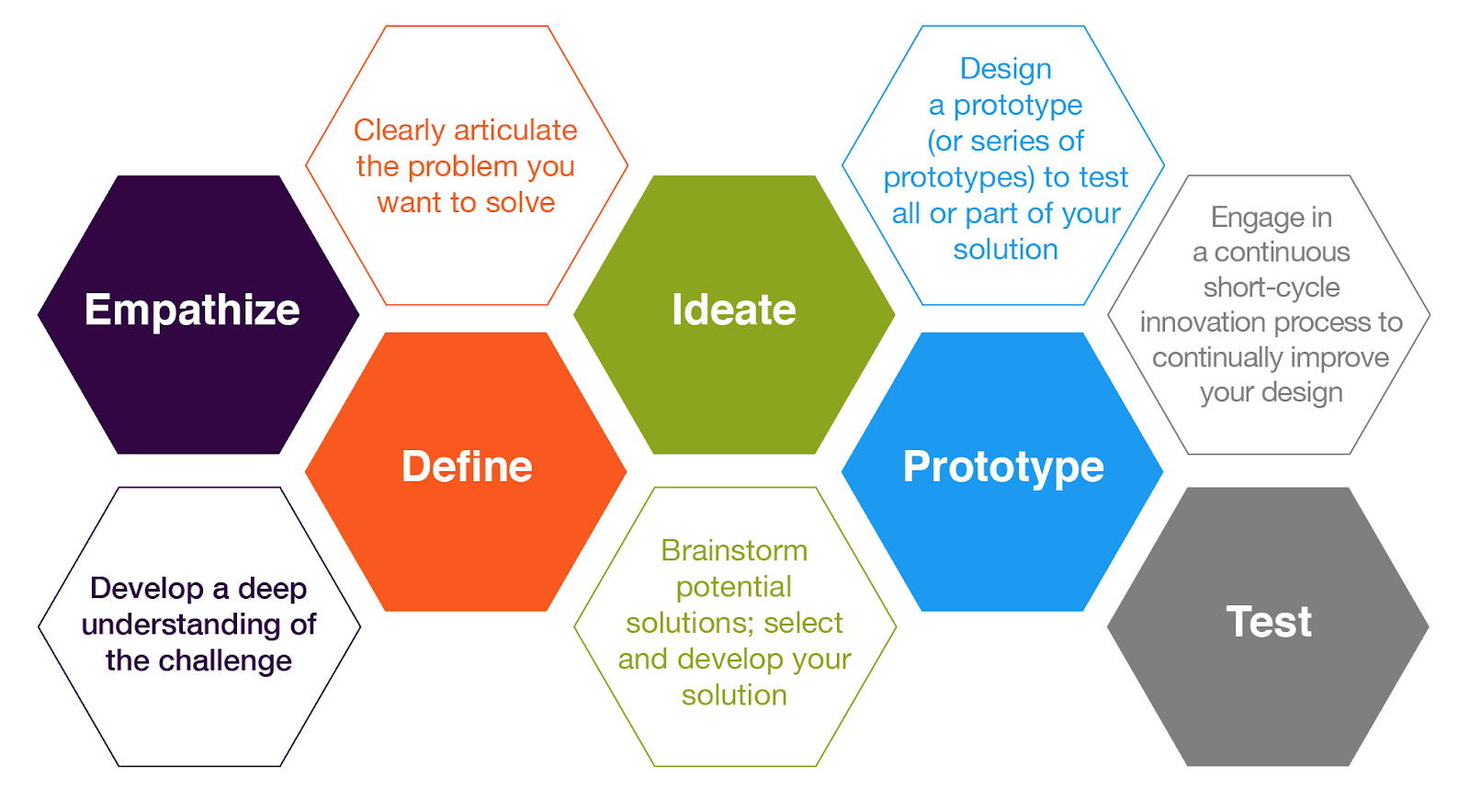
When we apply this thinking to product design, the process can be broken down into 5 phases:
- Define the product
- Research
- Analysis
- Design
- Test
- Defining the product
The beginning of the process is concerned with pinpointing why your product should exist in the first place. What is the problem you are solving? Will people want to use it? Will they enjoy using it?
To gain a better understanding of your product’s potential in the real world, you’ll brainstorm with fellow designers and key stakeholders to assess the business objectives your product is designed to meet.
You’ll think about the value proposition of your product: who will use it and why they will use it. This helps to define exactly how your product will satisfy both users and the business.
The final phase will be to sketch a low-fidelity wireframe of the final product which will then lead into a kick-off meeting where you can present your strategy.
The kick-off allows you to manage the expectations for the entire process. You’ll decide who will collaborate, how they’ll communicate, and how you’ll meet the business’s needs such as KPI’s.
This initial phase of exploration lays the foundation for the next stages in the design process.
- Research
Investing in research early on will save stacks of time later down the road and much to the boss’s delight, money too.
Properly utilising this phase of the design process promotes empathy with the users. User empathy allows UX designers to develop a deep understanding of their target audience and subsequently, how their product will fit into the market.
Typically, research methods consist of:
- User interviews - directly speaking with the end-user either by interviews or surveys to establish their needs, wants and fears
- Market research - looking at industry standards, competitive products, and identifying potential opportunities for your product
As tempting as it can be to just jump on Google and fire up a search, you’ll bear greater (and more accurate) results by actively engaging your audience.
- Analysis
At this stage, you’ll take all of the information collected from research and dig into why the user has a want or a need for your product.
Drawing on elements of behavioural psychology, an idea will start to form for what your ideal user will look like, their personality traits, goals and motivations and finally, their frustrations.
This profile manifests in the form of a “user persona”. You might hear it being referred to as a “customer persona” or “buyer persona” too, but fear not, it’s all the same thing.
What the user persona allows us to do is create a fictionalized character that best represents a product’s target audience.
Here’s an example from Xtensio:
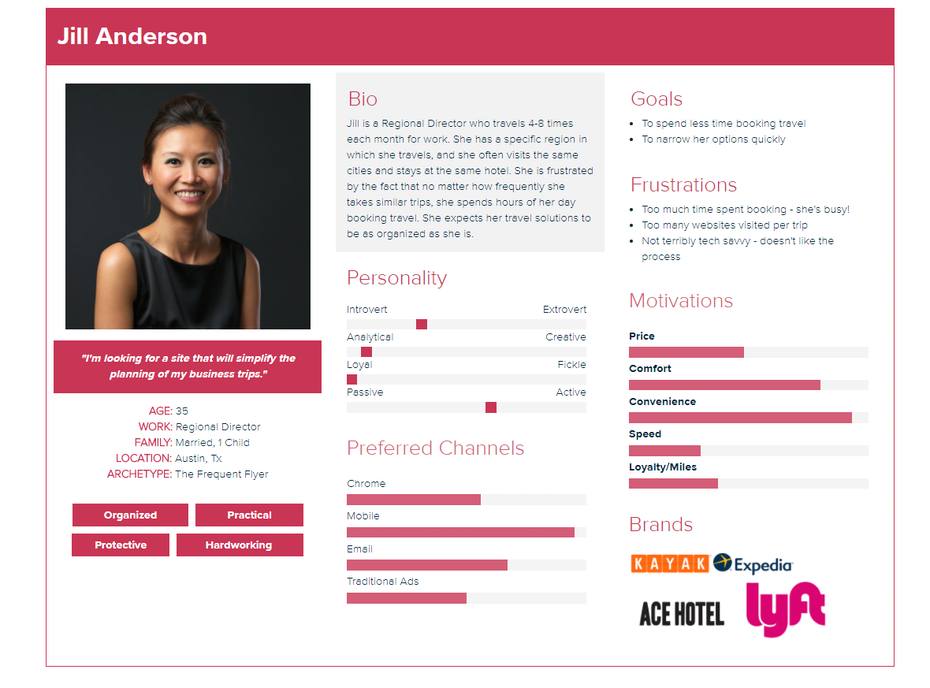
This user persona brings our character to life with intimate details about their characteristics and what they are trying to achieve.
Potential customers can now visualise this person interacting with our product. It helps to tell a story and attract similar users.
- Design
Now we can start to ideate designs that embody all of the research and data that came before.
This usually begins with IA (information architecture) which essentially labels the different points of navigation on a digital product (like pages and menus) and where content will be placed. IA will be your skeleton for the product design.
Next, grab yourself a pencil and a pad and get creating!
Seriously though, the design phase is gold because you can go old-school and sketch down ideas on a pad or use software tools to draw up designs. Sure, there are suggested principles to follow but there are no bad ideas!
Getting your designs down and sharing amongst the team gives way to a creative synergy where the real magic happens.
With said magic in hand, you’ll then create a wireframe that will act as the backbone for your product.
UX Wireframes allow the whole team to determine what works and what doesn’t, eventually deciding on the structure, visual hierarchy and which elements will remain.
The image below illustrates the change from low-fidelity to high-fidelity wireframe.
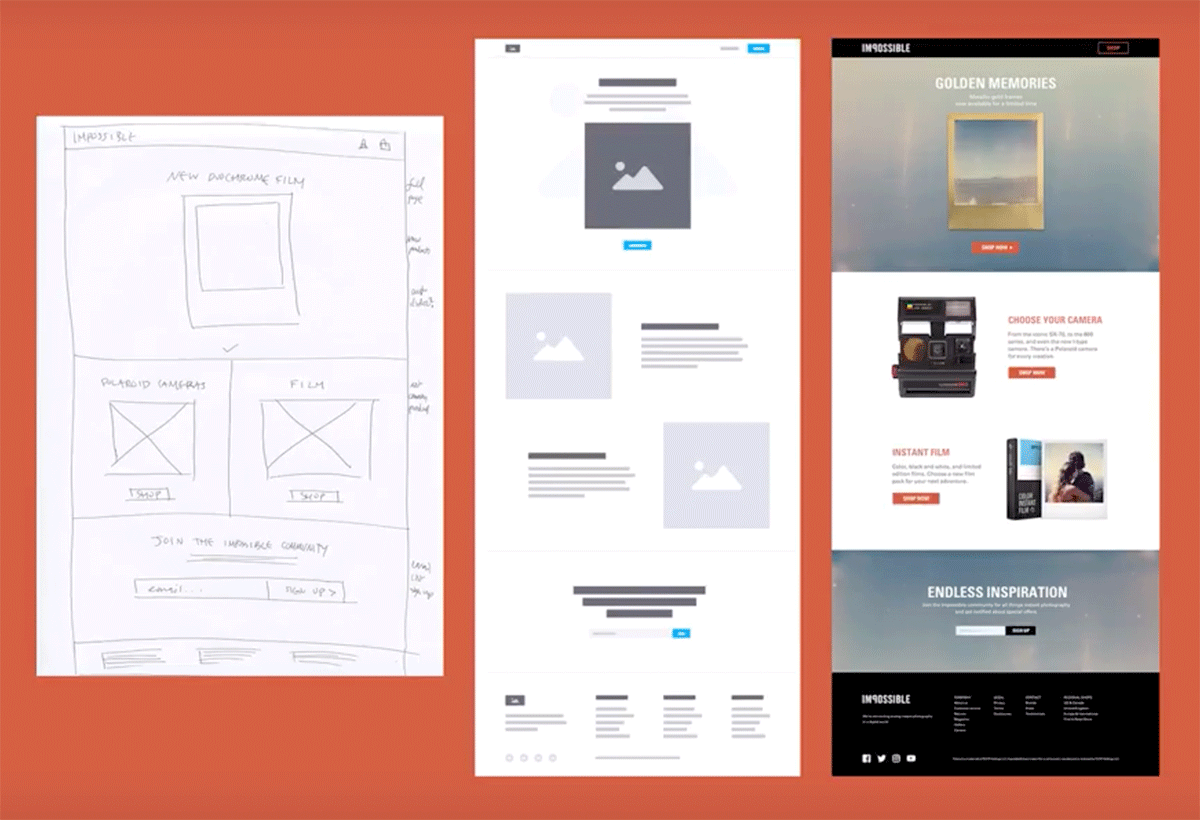
Following this will be the prototype phase. Usually, after the structure is in place, this is when the UI designer will come in and add visual elements such as typography, buttons and colour palettes.
Prototypes provide a simulation for how the end-user will interact with your product and when ready can be deployed to users and management for feedback.
- Testing
This is where your team discovers if all of their hard work has paid off.
You’ll present your product for feedback amongst different users and validate the findings.
The first port of call will be your team. Run wild with the product and stress test it for flaws.
Next, you can put the product in the hands of real users otherwise known as usability testing. With people who represent your target audience and measure their feedback. This might be moderated sessions or with focus groups and be sure to include split or A/B testing for broader results.
Finally, you’ll analyse quantitative data like clicks and navigation speeds to determine how users are interacting with your product.
Following this entire design process provides all of the data you’ll need to revise your product, get to the point of completion and deployed in the market.
Lean UX
If you’re wondering what Lean UX is, read on for a brief overview of how it came to be and why it’s now synonymous with intelligent design teams across the globe.
Jeff Gothelf introduced Lean UX to the world when he published his book in 2013, “Lean UX: Creating Great Products with Agile Teams.”
After a number of years spent in the UX design field, Gothelf recognised a pattern of frustration and inefficiency among design teams in how the common UX process was being implemented.
After a few years of working and ironing out the kinks within his team, Gothelf took his Lean UX management system to a wider audience. And it’s been catching on ever since.
Check out this diagram showing the Lean UX cycle:
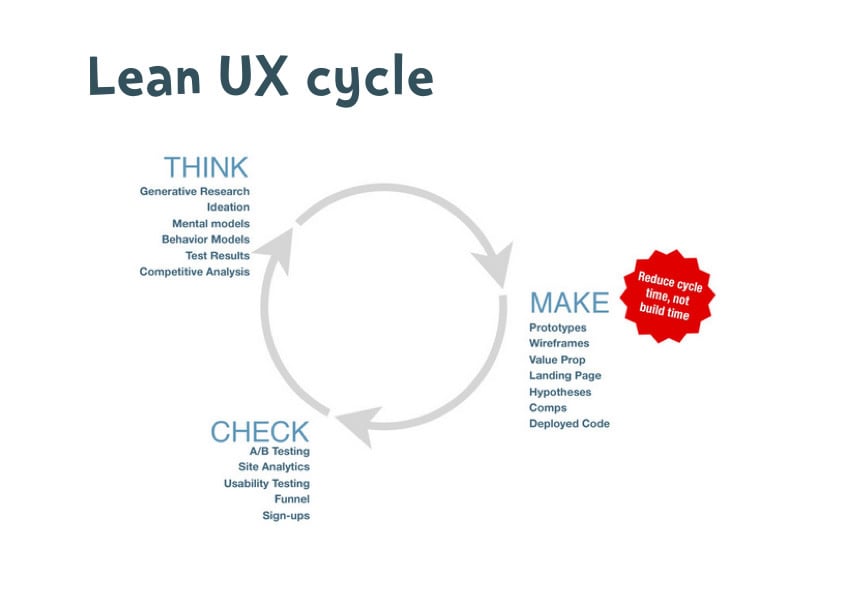
As stated by Gothelf, Lean UX is really a mindset.
It’s about removing unnecessary processes that slow design teams down and increasing frequent collaboration and communication between ALL parties. Total transparency.
And the whole gang needs to get on board for it to work.
When they do, you’ll see greatly improved efficiency as potential issues that may have crept up later down the road are nipped in the bud early on.
Dramatic pushes at the experimentation stage mean that ideas can be trialled, tested and the data fed back to design teams to be reviewed and altered if needs be.
It’s a beautiful marriage of communication, collaboration, creativity, analysis and efficiency.
Here’s a YouTube video of the man himself, Jeff Gothelf talking all things Lean UX.
Agile Methodology
Back in 2001, a group of software developers published the “Manifesto for Agile Software Development.”
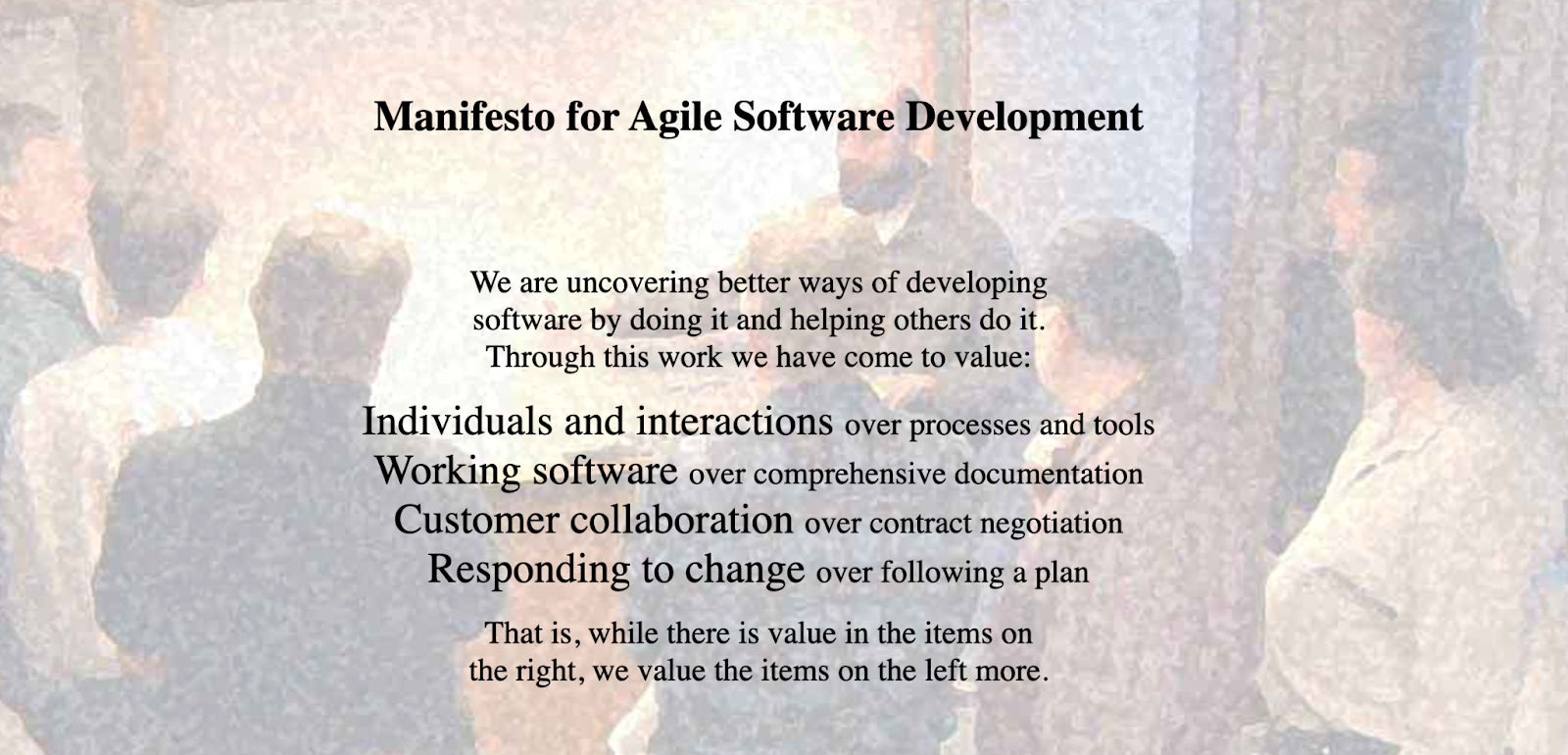
Yeah, we noticed it too. Graphic design has come a long way since ‘01.
When we deconstruct Agile software development and apply it to UX, we understand these basic principles:
- Collaboration - your team needs to adopt the mindset that every member of the team is instrumental in the design process. UX, Agile and Lean design processes combine for an iterative experience that betters the development and execution of a product.
- User Feedback - gauging feedback from end-users early on informs design, development and testing.
- Incremental Work - through the Agile framework, projects are completed incrementally, sometimes called ‘sprints.” (see image below) These continually evolving but shorter work cycles mean that developers and designers can respond quicker and more easily at each stage of design.
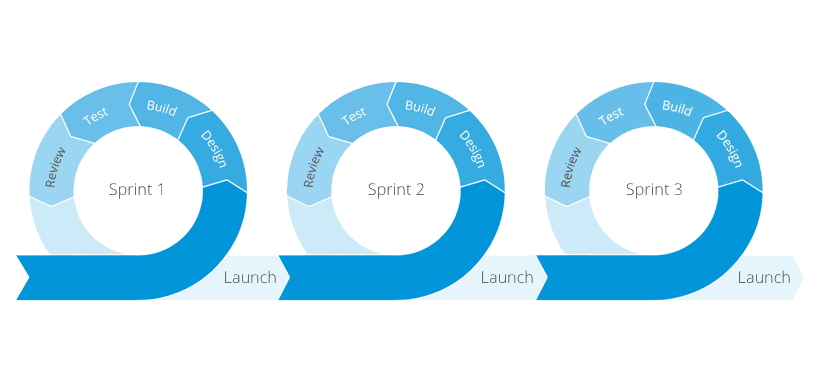
To sum up, Agile is a project management methodology that encourages shorter product cycles to rapidly speed up production and is constantly being revised.
There are numerous Agile methodology frameworks such as Scrum, Kanban, Lean, XP and Crystal - check out this explainer video from Edureka to learn more.
UX Research
UX research is how designers give context to their product.
Using different methods, UX researchers study their target users to understand their requirements and gain valuable insights, all of which aid the design process.
This research is defined as the following:
- Qualitative research - this is about understanding why users take action (or don’t) and also any preconceived notions they may have about your product. This type of research might take the form of interviews or studies and is largely opinion-based. But it also represents true human responses which makes it invaluable for tweaking development and design.
- Quantitive research - this method allows you to analyse findings from larger pools of data, for example, surveys asking users about a specific habit like exercise or diet. Because your feedback is derived from a wider user base, you can make objective conclusions based on the responses and make adjustments accordingly.
Both of these methods rely on the other to deliver the most accurate results. The opinions of a few, without the feedback from the many, will produce inconclusive results.
Try to get familiar with both for maximum effect.
UX research also employs two approaches for how feedback is measured:
- Attitudinal - assessing why a user feels the way they do about an experience.
- Behavioural - focusing on the actions a user takes, in the moment.
As with qualitative and quantitative methods, both attitudinal and behavioural approaches have more effect when applied together.
Here’s a table showing common types of UX research from NNG.
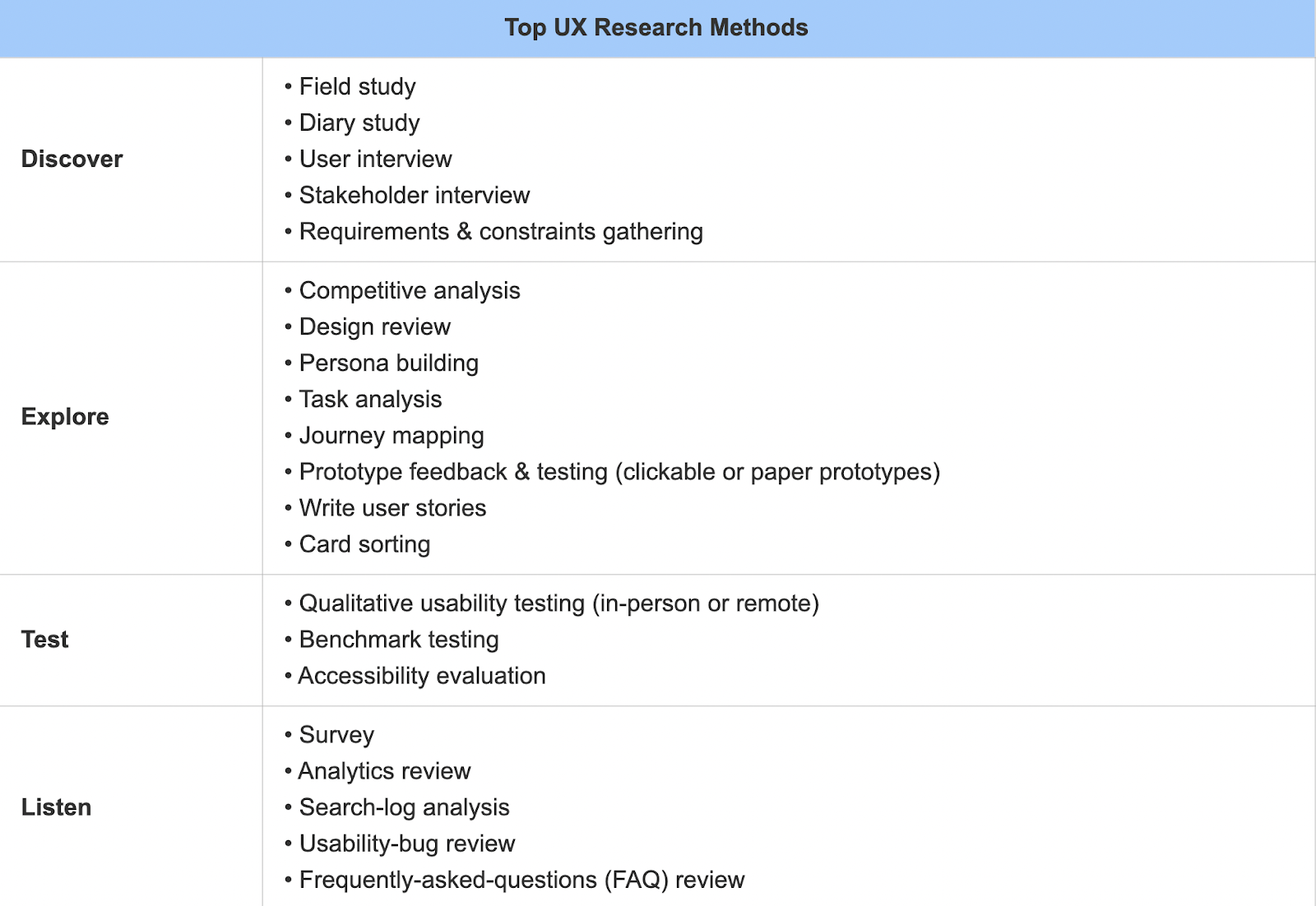
And for the best results? Conduct UX research at every stage of the design process!
Wireframe
Sounds familiar but what is a wireframe?
A wireframe can best be described as the way we design website services at their structural level. Wireframes are created to show the layout of content and functionality on a page before visuals (UI) and content (copy) is added further down the line.
Naturally, a wireframe will be used early in the design process as it helps to visualise what will appear on the webpage and where elements like buttons and menus will go.
Wireframes are excellent when presenting initial design ideas to management teams and clients for review as they can be amended without too much fuss and loss of time.
This plays into the Lean/ Agile methodology is an iterative and incremental design process.
Check out this wireframe video from FreeCodeCamp to find out more.
UX and Usability Testing

UX Design Introduction
What is UX Design
UX Definition
UI vs UX Design
UX Designer Salary
UX Design Process
UX and Usability Testing
UX Design Examples
UX Design Tools
How to become a UX Designer
UX Designer Portfolio
Final Thoughts
UX and Usability Testing
Usability testing is an observational UX research method whereby a facilitator will assign “users” a series of tasks to complete as they listen for feedback and observe the user’s behaviour.
It’s not as creepy as it sounds though. Usability testing helps designers and developers flag up product flaws and shortcomings before coding begins.
This graphic from UX Collective details the steps for Usability testing.
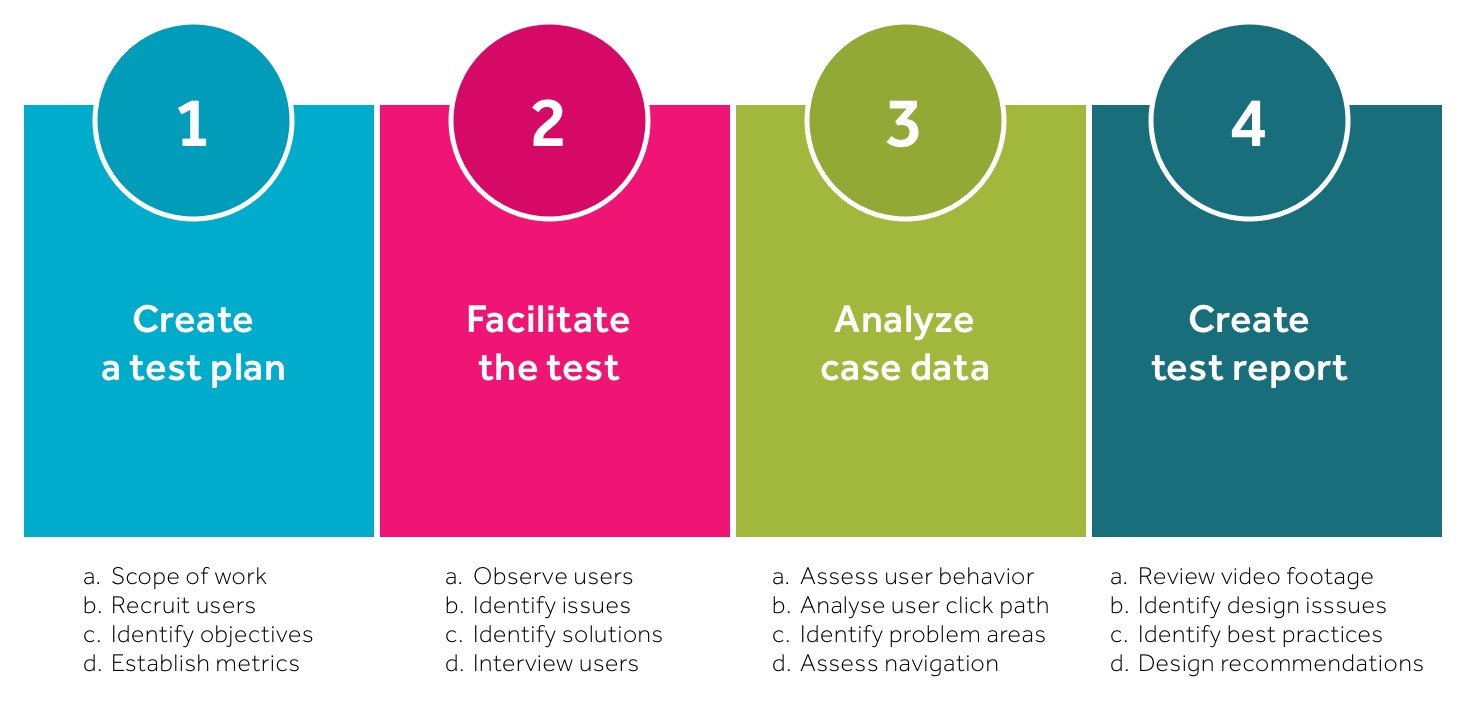
Raising and correcting these issues as early as possible prevents impact on schedule and saves money. It’s a win-win.
Here are a few of the benefits of conducting a usability test:
- Measure how easy is it for users to complete a task
- Measure how long it takes them
- Gauge user behaviours and satisfaction with your product
- Identify areas of improvement
- Analyse data to see if it meets your objectives
Plus, the tests can be done either in-person or completely remotely provided both parties have access to a computer and a webcam.
Read this article and watch the video for more info on Usability testing.
UX Design Examples

UX Design Introduction
What is UX Design
UX Definition
UI vs UX Design
UX Designer Salary
UX Design Process
UX and Usability Testing
UX Design Examples
UX Design Tools
How to become a UX Designer
UX Designer Portfolio
Final Thoughts
UX Design Examples
Intuitive, attractive and useful UX design will often be the difference between a user staying or leaving your site.
A survey conducted in 2018 by PWC revealed that 59% of customers would walk away from a brand they loved if they had multiple bad experiences. Not brands they liked, ones they loved.
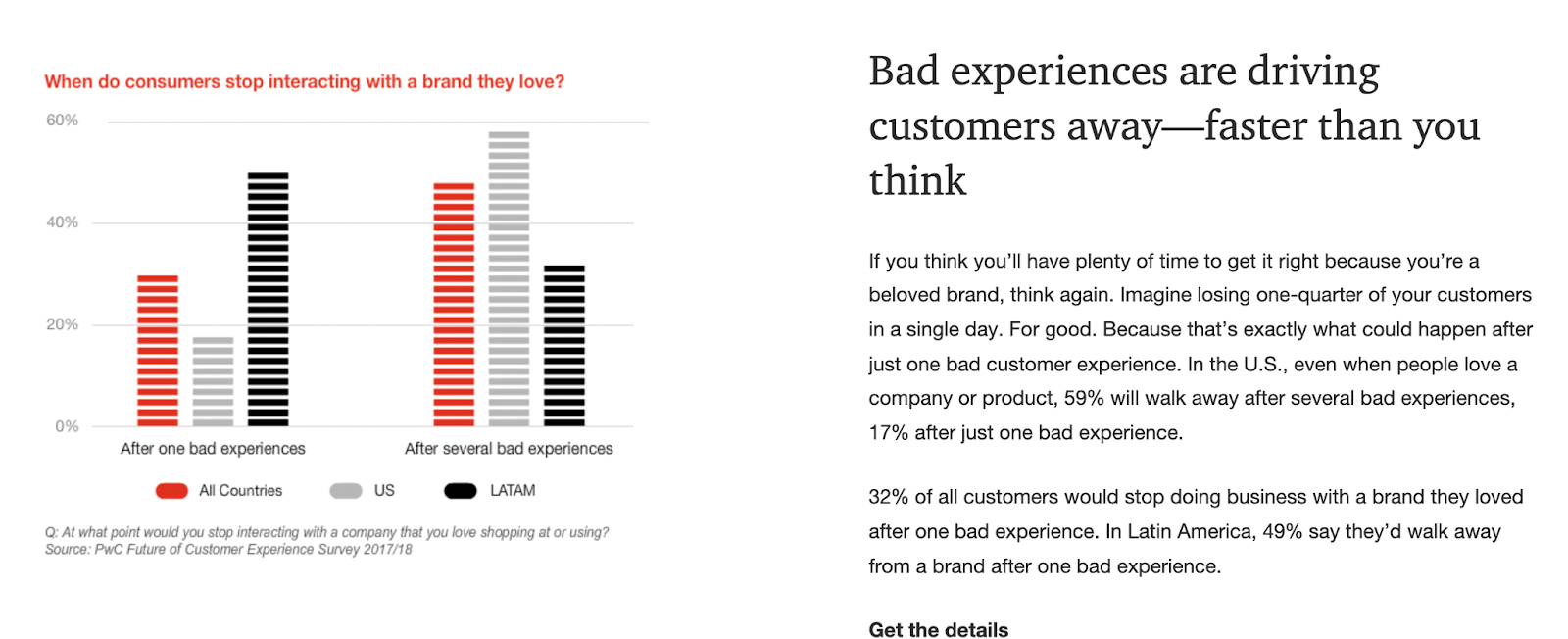
Intelligent UX design is more potent now than ever before and we think these brands are making the most of it:
- Airbnb
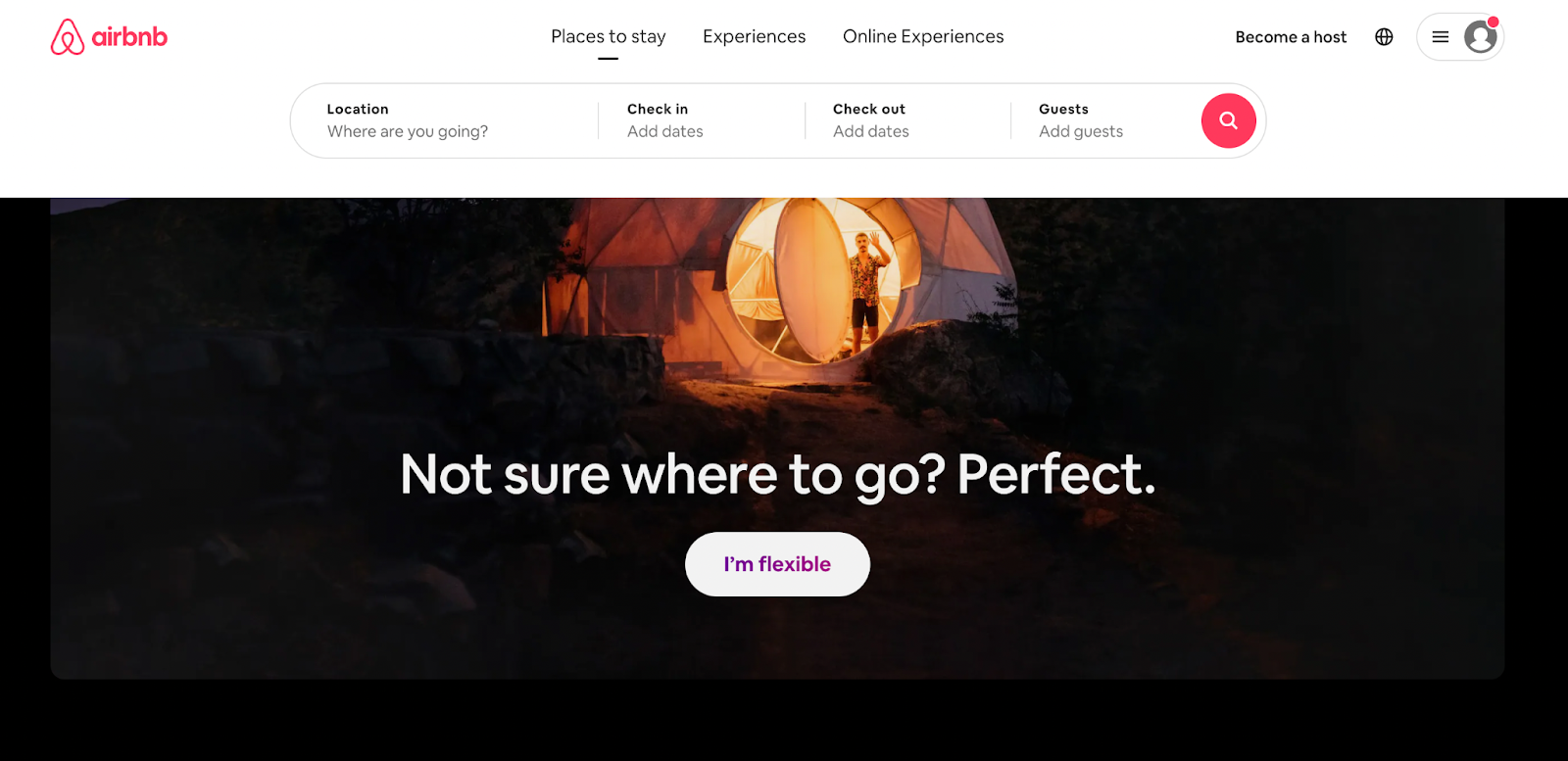
We’re huge fans of Airbnb’s booking experience - easy, attractive and flexible.
You can book accommodation virtually anywhere in the world in less than 5 minutes.
Airbnb is a great example of visual hierarchy working to maximum effect. It understands what users want to see and when they want to see it.
- Uber
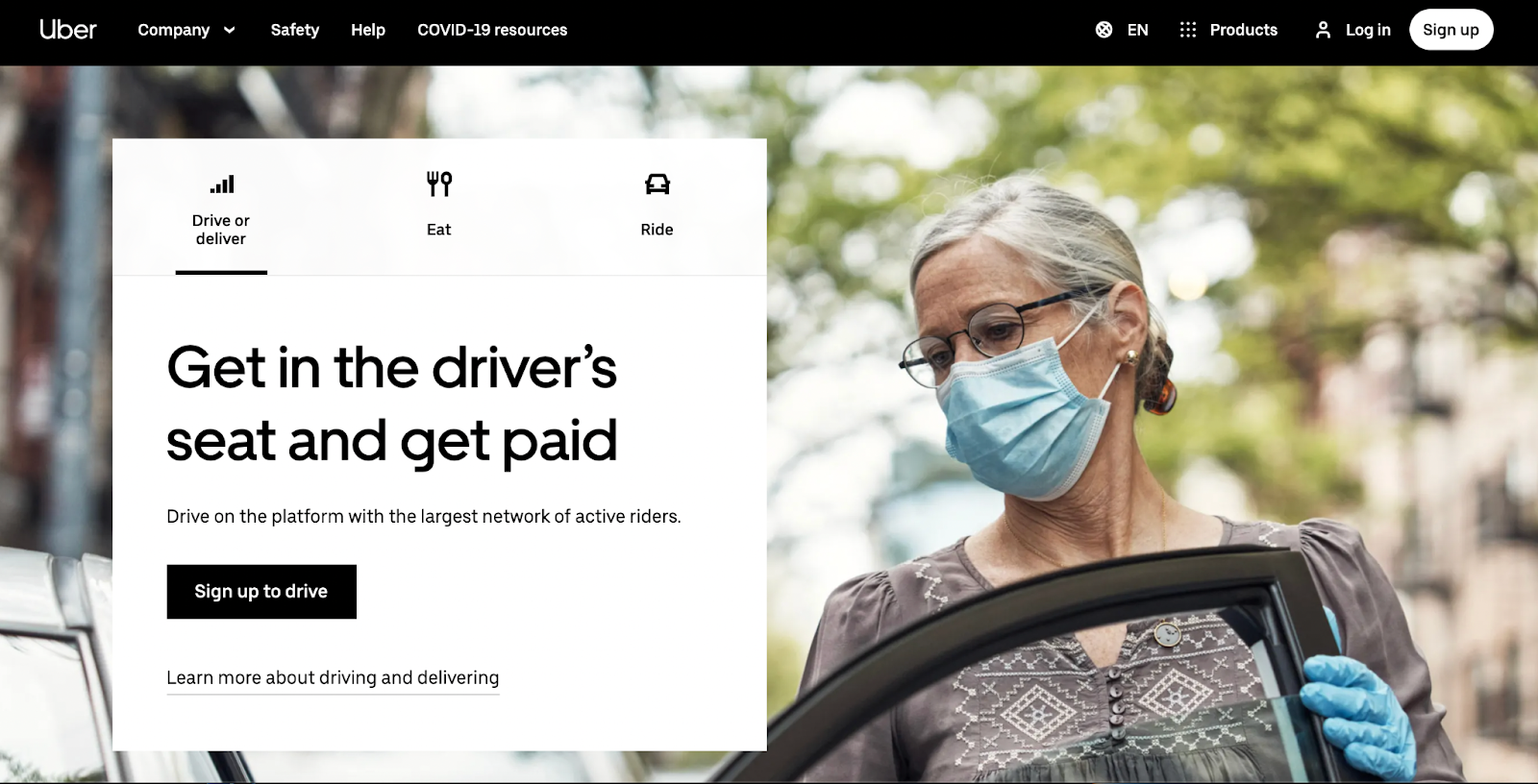
Uber manages to nail an extremely difficult UX problem - balancing the personas of both the user and the driver.
By understanding each of its prime users’ needs, Uber fuses the two for a credible and cohesive experience.
- Mailchimp
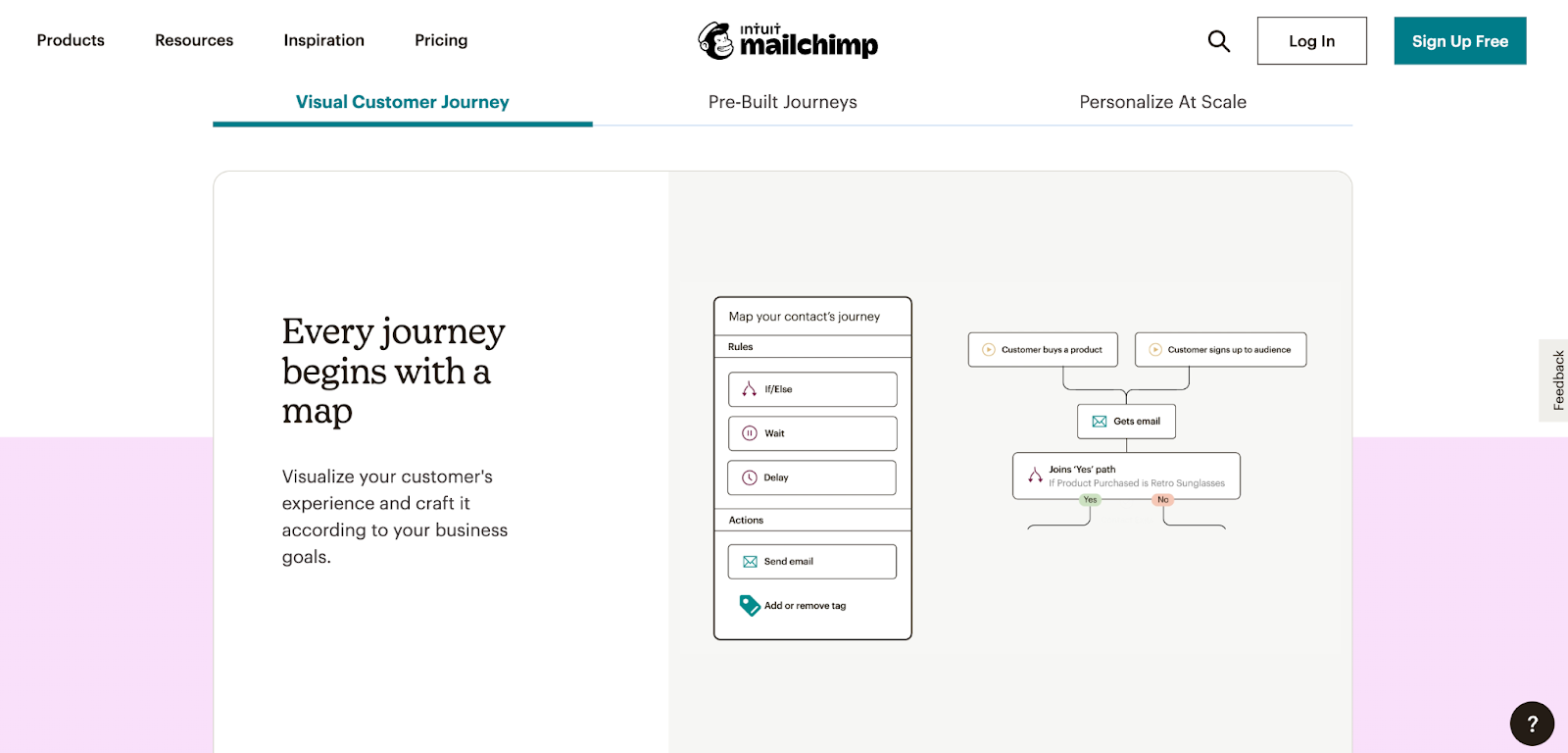
Mailchimp is the champion of email marketing campaign builders.
You could walk into their products with zero knowledge and within minutes, their exemplary UI and navigation will guide you through the entire process.
Mailchimp bat user flows out of the park.
More UX Design Examples
Hungry for more? Have a look at these UX design examples that are top of their game.
UX Design Tools

UX Design Introduction
What is UX Design
UX Definition
UI vs UX Design
UX Designer Salary
UX Design Process
UX and Usability Testing
UX Design Examples
UX Design Tools
How to become a UX Designer
UX Designer Portfolio
Final Thoughts
UX Design Tools
Before you can even begin to manifest your wild UX design ideas, you’re going to need some UX design tools.
UX design tools are the basis that informs information architecture, user flow and ultimately how that experience will playout for the user.
There are a few around and each offers its own preferred style and compatibility.
We’ve gone through the trouble (honestly, it’s no bother) of picking out a few of the best-known and trusted UX design tools so you don’t have to.
Here we go!
- Figma
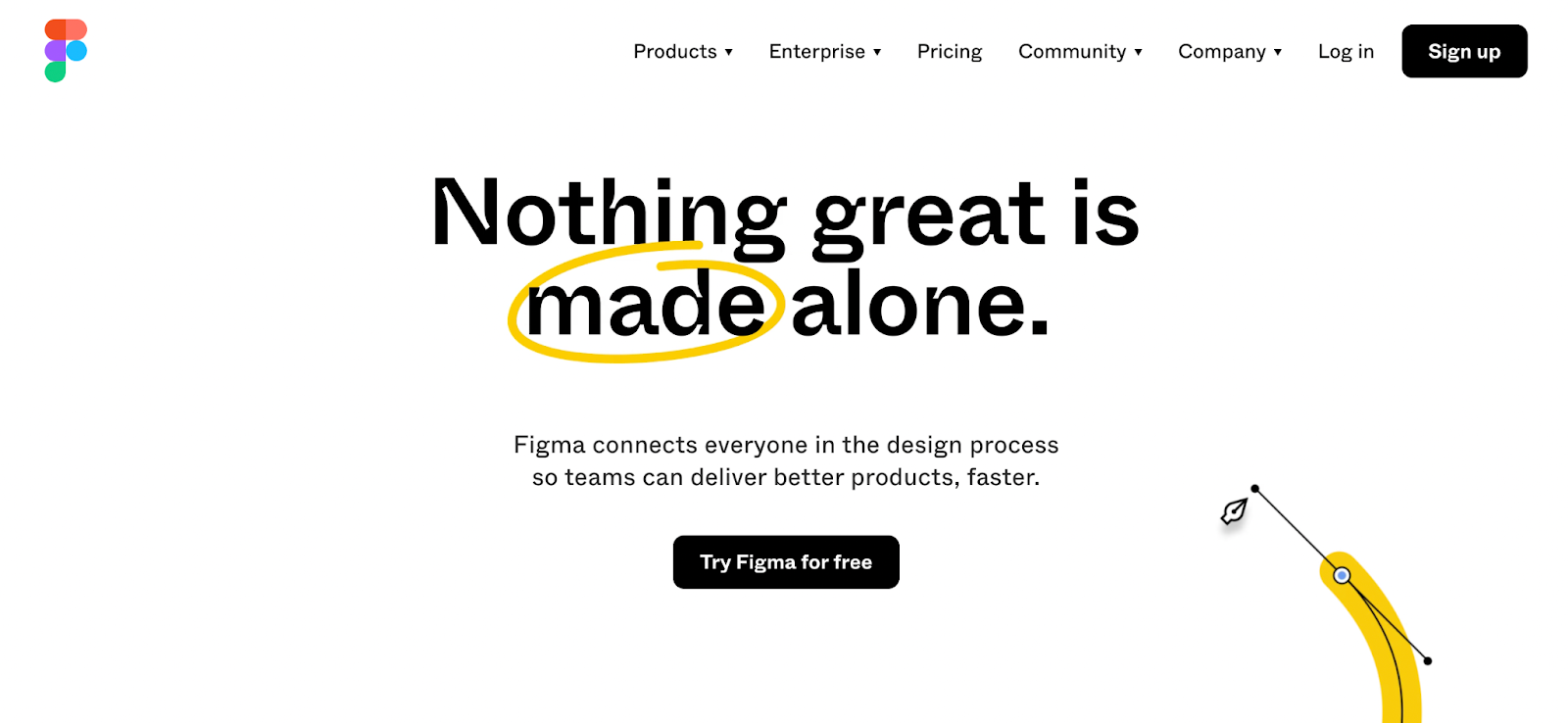
As a browser-based platform Figma allows collaboration from multiple users simultaneously to promote a truly iterative UX design process.
This makes it a great tool for designing and composing wireframes or interfaces on the fly and having multiple people working together at the same time.
Figma offers companion apps for iOS and Android and is compatible with Mac and Windows.
Figma also offers a free plan for users which makes it a very attractive UX design tool for many.
- UsabilityHub
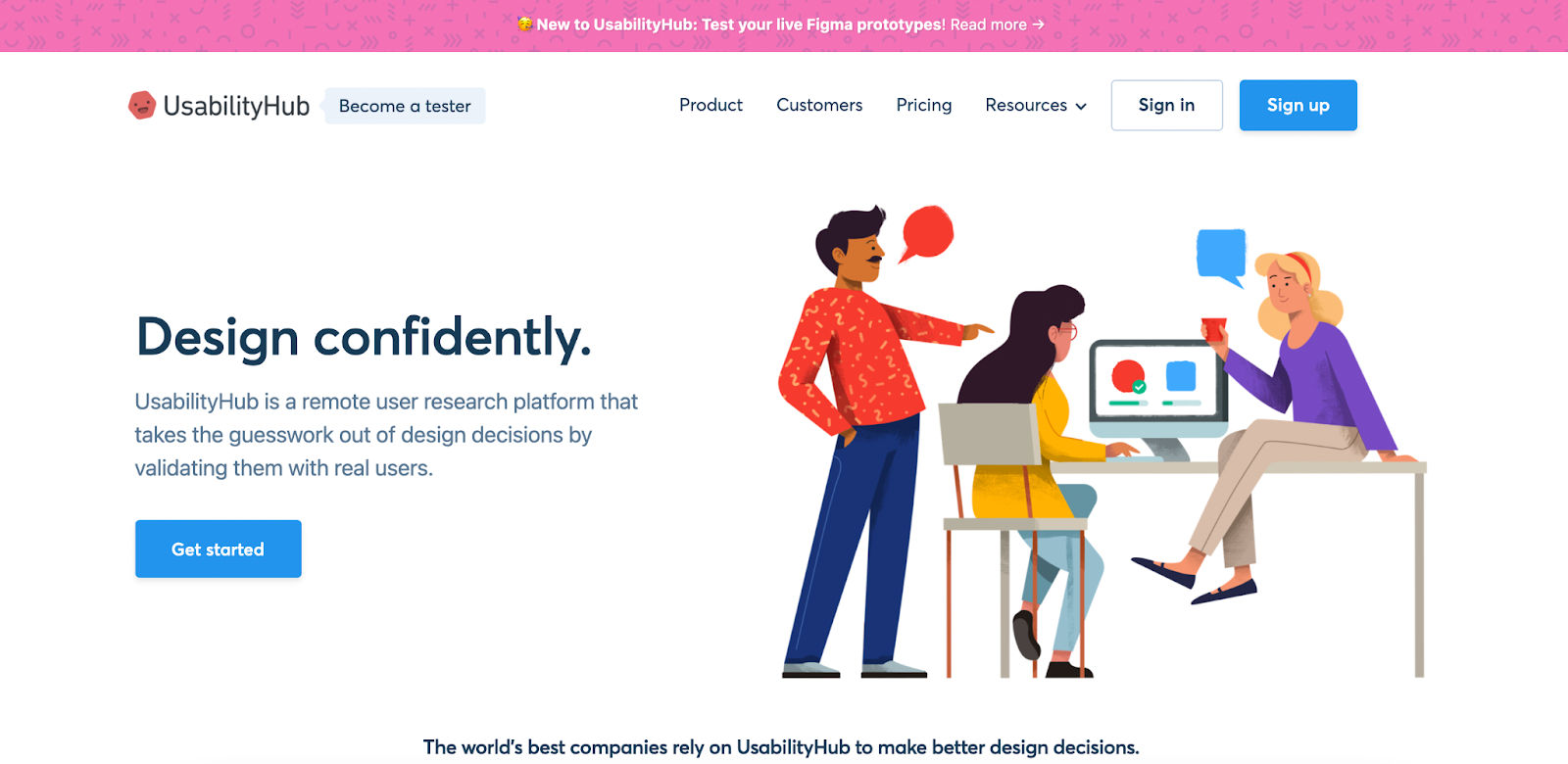
For the ultimate remote user research UX design tool, look no further than UsabilityHub.
UsabilityHub offers a suite of testing tools where teams can test live prototypes, design surveys or preference tests and analyse heatmaps, showing where and when users interact with your product.
UsabilityHub tests with real users to validate your design ideas and prototypes. For more on this popular UX design tool, take a look at these examples.
- Miro
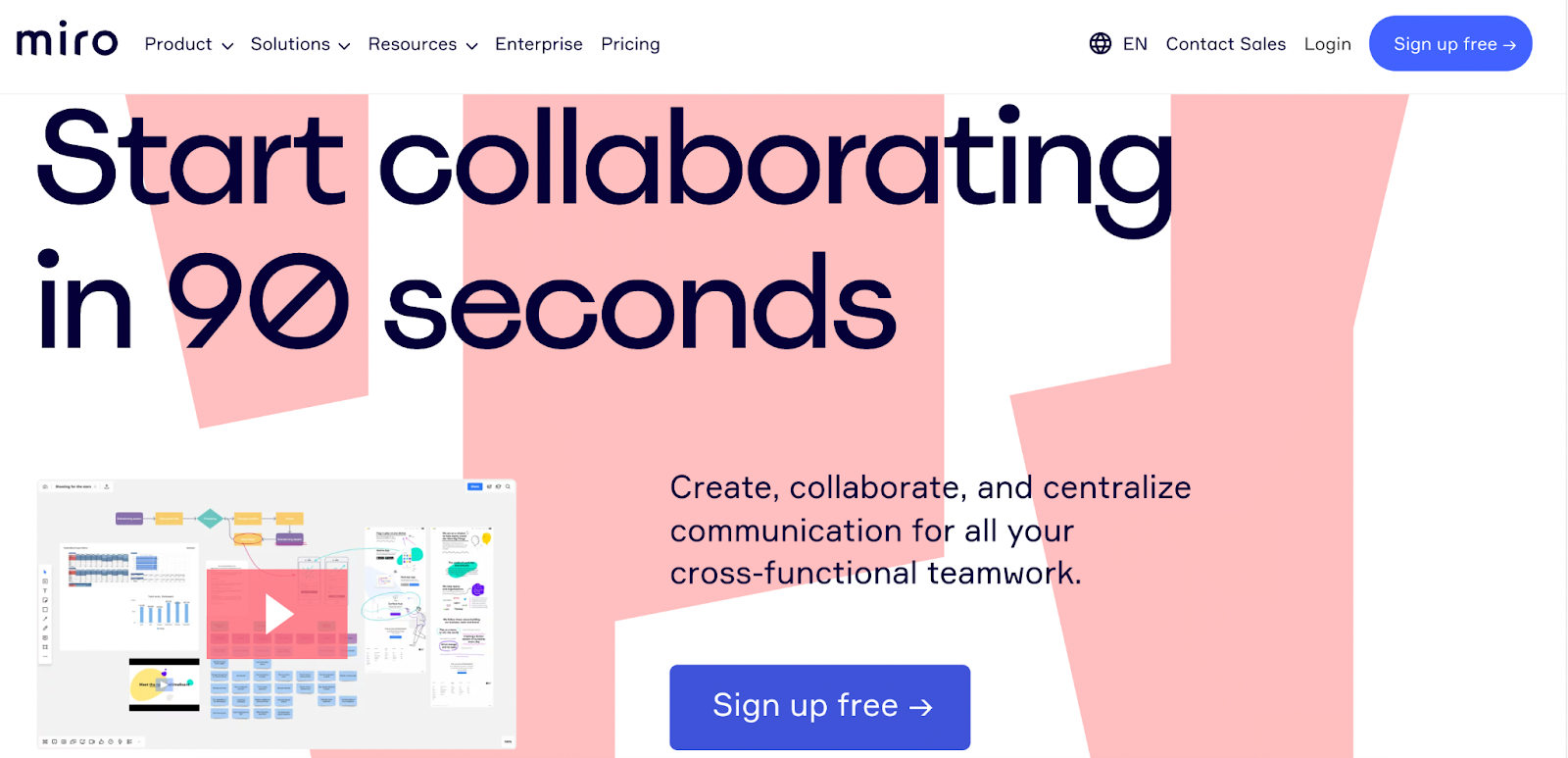
As stated by the strapline “Start collaborating in 90 seconds”, Miro is the place to be for centralizing communications across your entire design team.
Miro allows teams to come together remotely and ideate, research, design, strategize and even create low-fidelity wireframes all in one place.
It’s also free and if you’re unsure where to start they have a Miroverse packed with projects from the Miro community.
- Sketch

Sketch is a wildly popular UI design platform for Mac users.
Its major advantages are that it allows you to design high-fidelity interfaces and prototypes and instantly view them from different devices.
This is perfect when collaborating with your team and getting shareholder feedback early on before you hand off to developers.
Check out this handy intro video on Sketch.
The only notable drawback with Sketch is that it only works with Mac users. Sorry Windows advocates but we have something for you too.
- Adobe XD
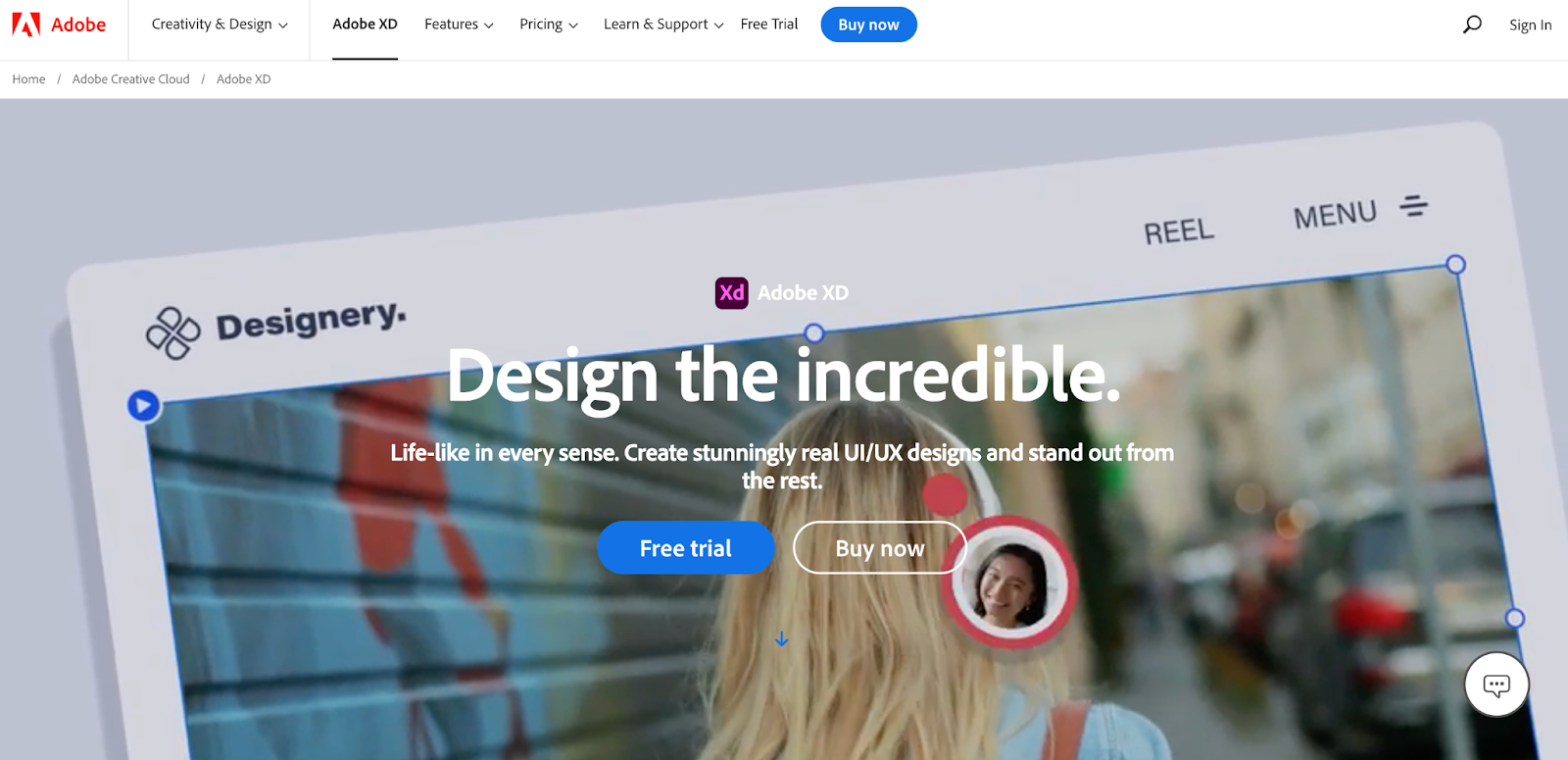
As part of the Adobe Creative Cloud, Adobe XD lets teams design, build and share user experiences for multiple channels.
Adobe apps have become industry standards in many cases as they offer such a diverse suite of tools.
Adobe XD works on both Mac and Windows and also offers a free trial for their paid plan.
How To Become a UX Designer

UX Design Introduction
What is UX Design
UX Definition
UI vs UX Design
UX Designer Salary
UX Design Process
UX and Usability Testing
UX Design Examples
UX Design Tools
How to become a UX Designer
UX Designer Portfolio
Final Thoughts
How to become a UX Designer
By now you’ve done a ton of research on what it means to be a UX designer and how to navigate the various stages of the UX design process.
And what better way to flaunt that know-how than to dive into a UX design course and solidify your skills!
Here at the Growth Tribe, we offer users a comprehensive UX Design Diploma that will help you launch a career in this diverse and hugely rewarding niche.
As well as taking a course (which we believe is the fastest and most efficient method for adopting a new skill), there are things you can do to beef up your UX design knowledge if you’re more of a self-learner:
- Immerse yourself in everything UX
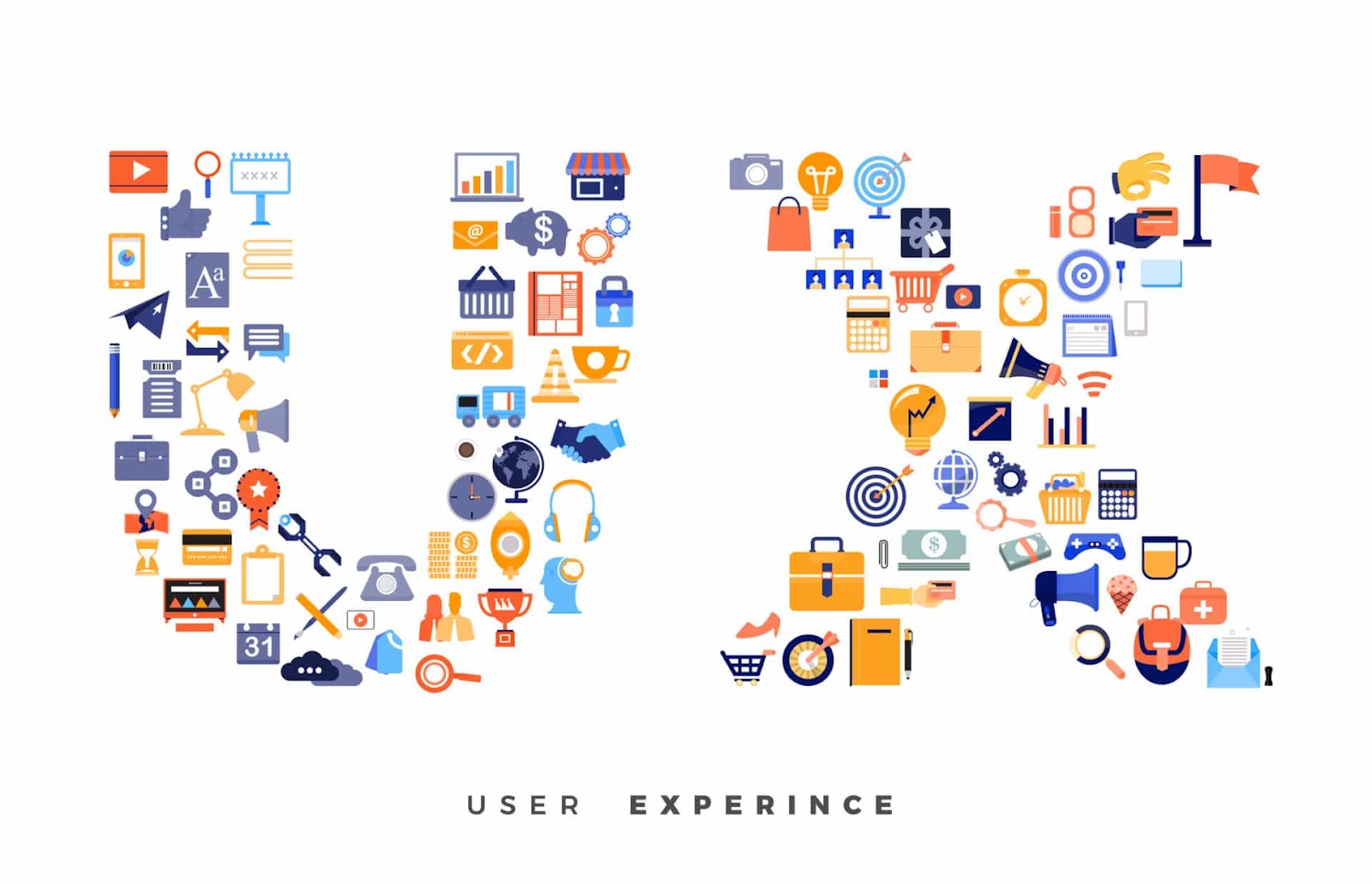
Really place yourself in the world of UX design and absorb as much information as you can.
Here are a few ways to do exactly that:
- Listen - Podcasts offer heaps of valuable insider knowledge from UX design experts. You’ll not only pick up practical tips and tricks but also more personal stories from some of the brightest minds in the business. Check out our list for the 11 Best UX Design Podcasts.
- Watch - YouTube has a wealth of content ready for mining. Channels like The Futur, DesignCourse and High Resolution are all fantastic sources for UX related content.
- Read - Follow UX Blogs for up-to-date shifts in the UX space and industry trends. There are plenty of excellent blogs online such as CareerFoundry, UX Planet and The Nielsen Norman Group.
- Join Groups - Whether it’s on Facebook or Discord, find like-minded creatives to share your passion with. There’s usually a mix of beginners and veterans among the groups which makes them perfect for all skill levels.
- Start deconstructing and designing
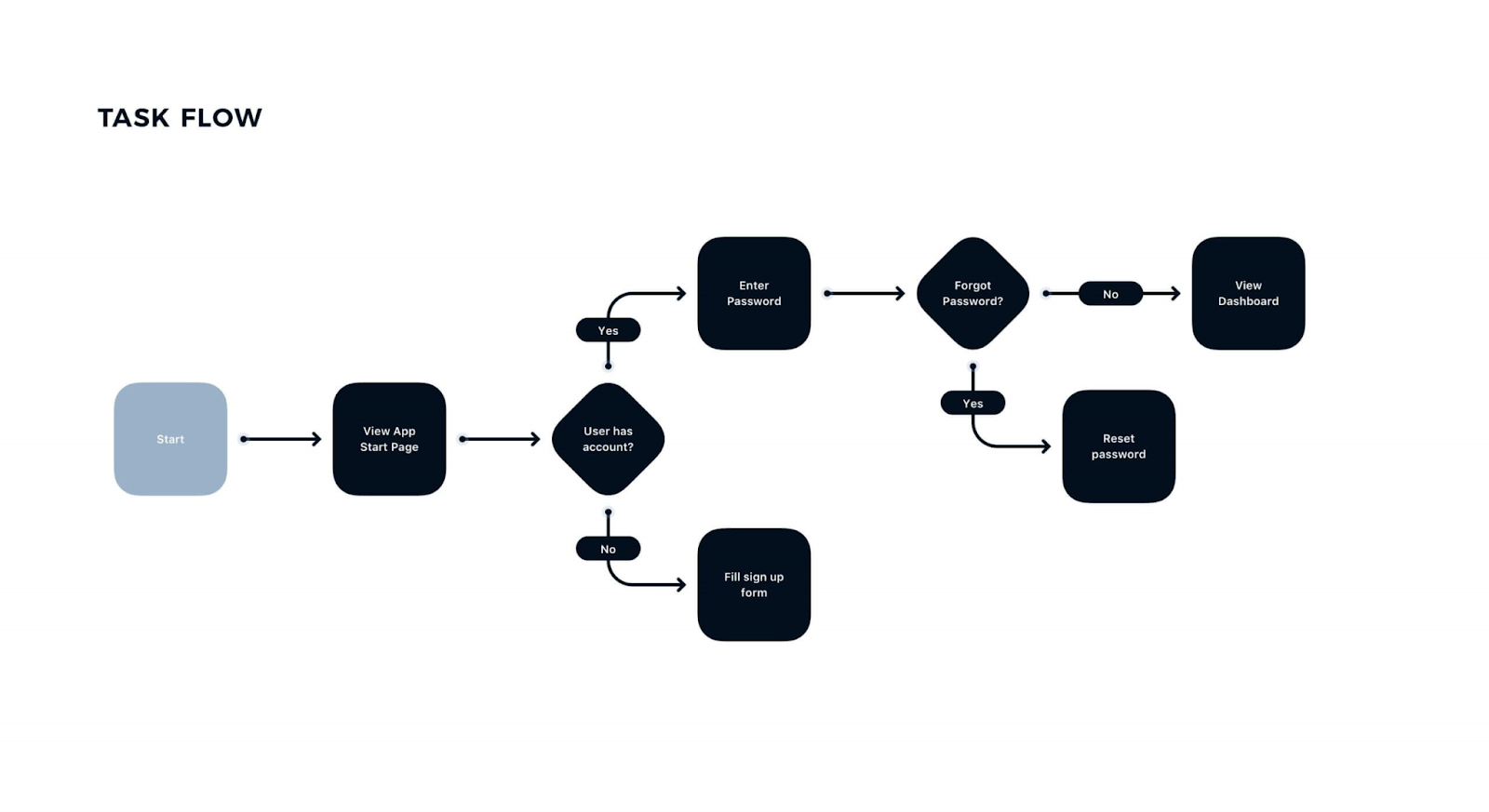
Come up with ideas and put pencil to paper!
Exercise your creative muscles by taking inspiration from brands around you and have a go at deconstructing and reconstructing user flows with your own spin.
Things to think about when you’re practising are:
- Does the user experience work?
- Why or why does it not work?
- How does it feel?
- What would you change and why?
- Try different UX design tools
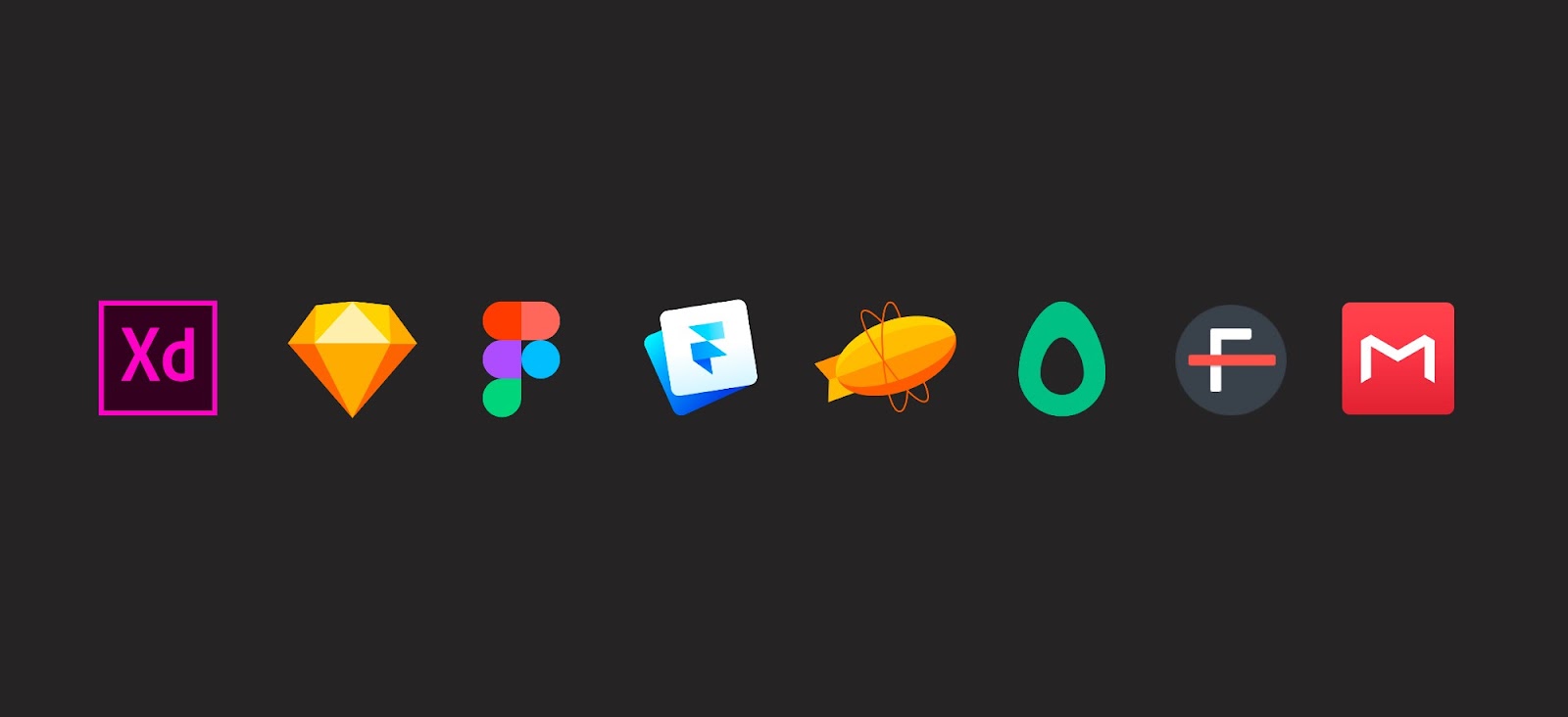
Learn the UX design tools of the trade. We mention a few in Chapter 9, most of which have free plans or free trials like Figma so you can get a feel for the real thing.
Some will be harder to learn than others but remember, there are always supporting articles and tutorial videos available online to lessen the learning curve.
UX design tools will help get your ideas from concept to wireframes and eventually prototypes.
- Volunteering and Internships
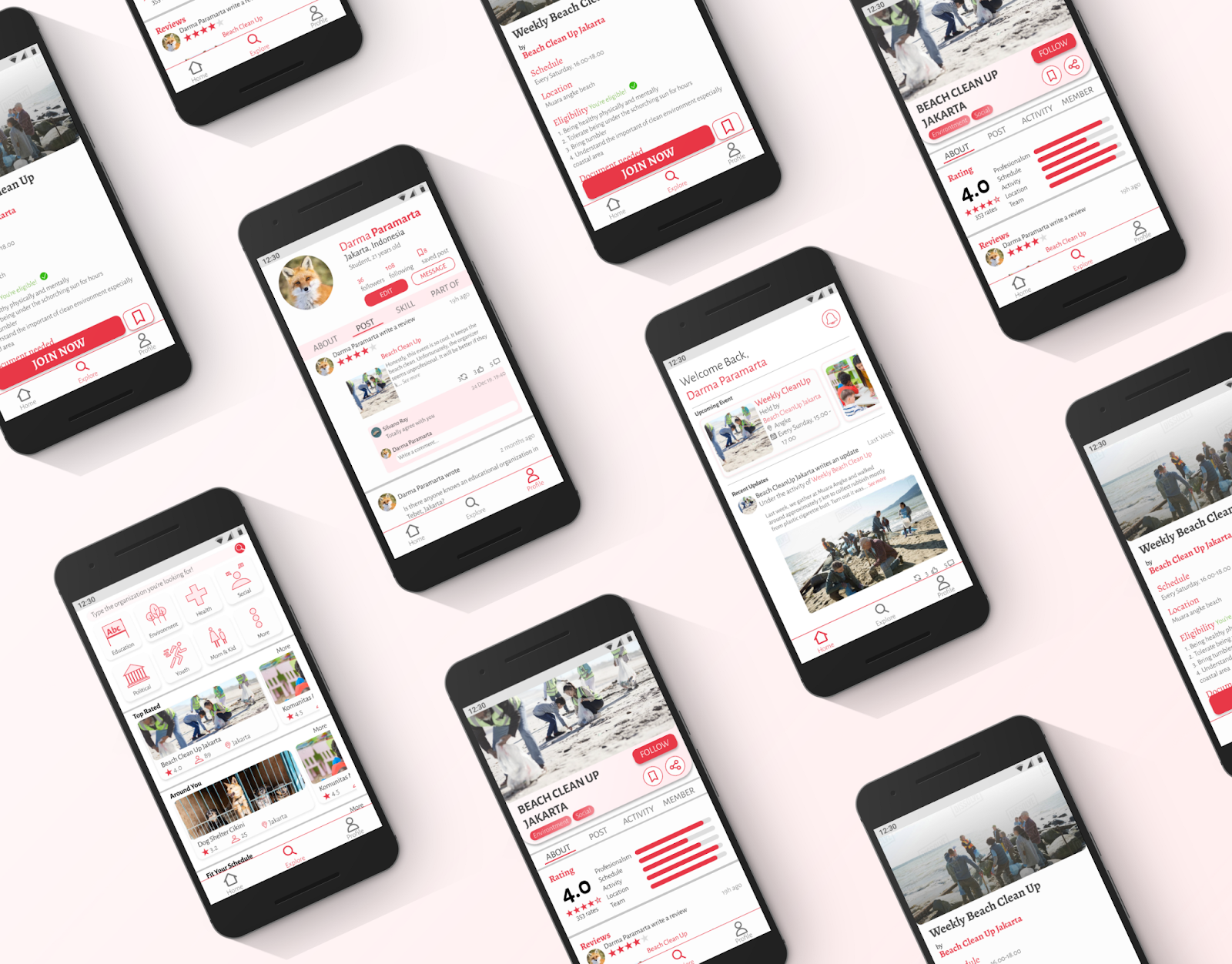
Get real-world experience by volunteering for projects through charitable organisations such as Taproot+ and Catchafire.
This is a fantastic way to get a glimpse of how design teams collaborate and to share and grow your knowledge.
Plus, it’s all for a good cause and we can get behind that.
For internships, check your local job sites for nearby companies looking to take on UX designers.
- Build a portfolio

Once you have some experience behind you, it’s time to create your very own UX design portfolio!
If you have already enrolled in a course, such as Growth Tribe’s, you will create a portfolio as part of the modules.
Alternatively, companies like Behance and Dribble offer online portfolio creation tools to display your work.
- Apply for UX design jobs
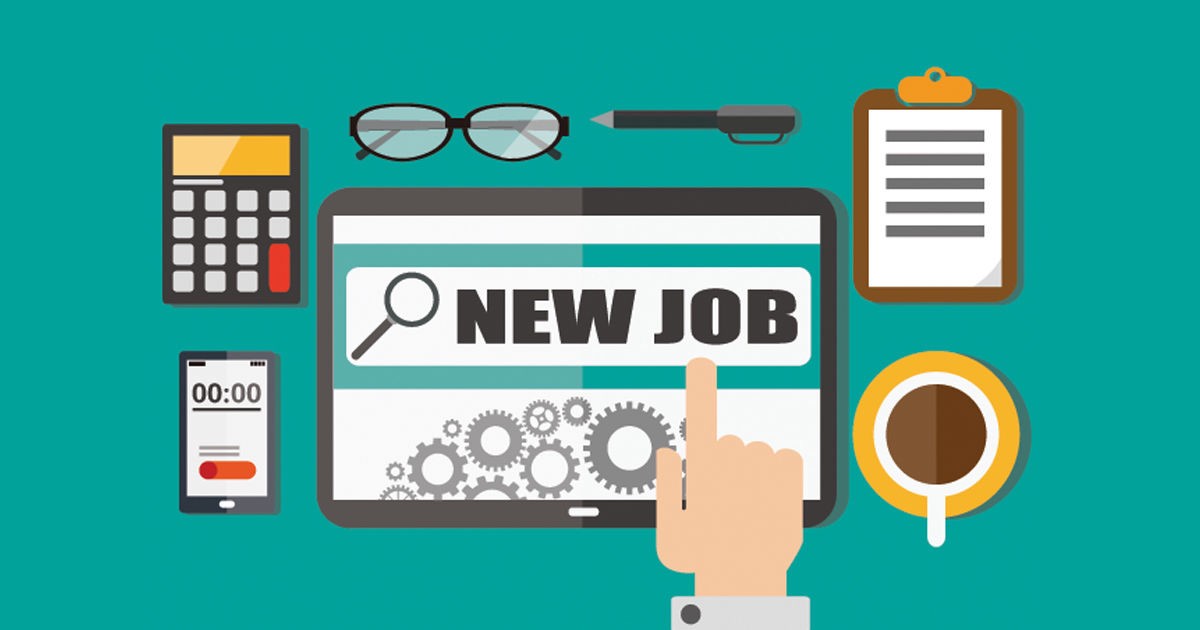
Feeling ready? Time to hit the careers pages and find yourself a shiny new UX job.
Whether you’re just starting out or have been a UX designer for a while, you’ll find high demand in everything from junior positions all the way up to lead designer roles.
For the UK there are popular job sites like Indeed. Or register yourself as a UX designer on platforms like Bark where employers can seek you out instead.
If you’re curious about how much the salary is for a UX designer, we cover some industry standards in Chapter 5.
UX Designer Portfolio

UX Design Introduction
What is UX Design
UX Definition
UI vs UX Design
UX Designer Salary
UX Design Process
UX and Usability Testing
UX Design Examples
UX Design Tools
How to become a UX Designer
UX Designer Portfolio
Final Thoughts
UX Designer Portfolio
Before you show the world what your UX design skills are made of, your UX designer portfolio needs to be up to scratch.
Far from just showcasing projects, the portfolio represents your creative perspective on shaping user experiences.
Here are a few best practice tips to get you started:
- Talk about the project
It’s not enough to solely rely on pictures (as pretty as they may be). Prospective employers want to know the finer details. When describing a project, keep these questions in mind but don't waffle!
- Who initiated the project
- What was the conversation/ motivation behind it
- How did you approach the research
- Briefly explain your next steps
- What did you learn from the project
- What would you do differently next time
For inspiration take a peek at these superb portfolio examples.
- Let the UX take the lead
Employers are scanning through dozens of portfolios when searching for the right candidate.
It goes without saying that you’ll want to stand out. To do this, be aware that your designs are the showpiece.
Guide your viewers through a visual journey and try to incorporate your own personality too. Here are a few examples to sink your teeth into.
- Research competitors
To know if you’re on the right track, take a look at what other UX designers are doing. Check who’s competing in the same niche and also, what sorts of designs are favoured in different fields.
Dribble has thousands of portfolios to take cues from.
- Be honest and open
Nobody is perfect. Except maybe Tom Hanks. We mean, he’s pretty special.
But for the rest of us, it’s okay to put our flaws out there and employers will appreciate the honesty.
When talking about your experience on different projects, mention the setbacks, how they impacted the process, and what your response to them was.
This shows resilience, emotional intelligence and that you can articulate thoughtfully. All important skills for UX designers.
Final Thoughts

UX Design Introduction
What is UX Design
UX Definition
UI vs UX Design
UX Designer Salary
UX Design Process
UX and Usability Testing
UX Design Examples
UX Design Tools
How to become a UX Designer
UX Designer Portfolio
Final Thoughts
Final Thoughts
Congratulations! If you’ve stuck with us there’s nothing in your way to becoming a top-notch UX designer.
Hopefully, this Ultimate Guide to UX Design has answered some of the burning questions you might have and has lit a fire under your UX design dreams.
Be sure to subscribe to our blog at Growth Tribe for more on UX and other digital skills.